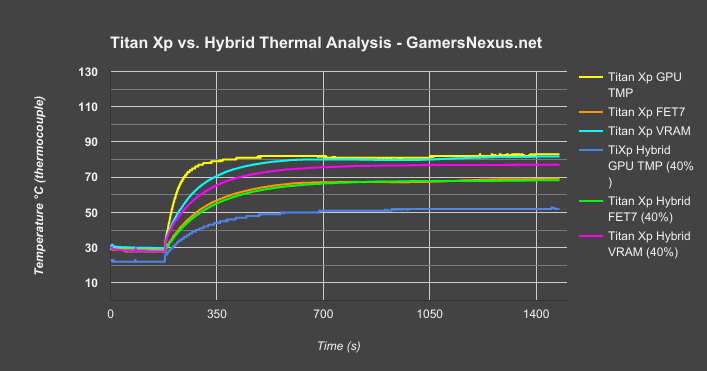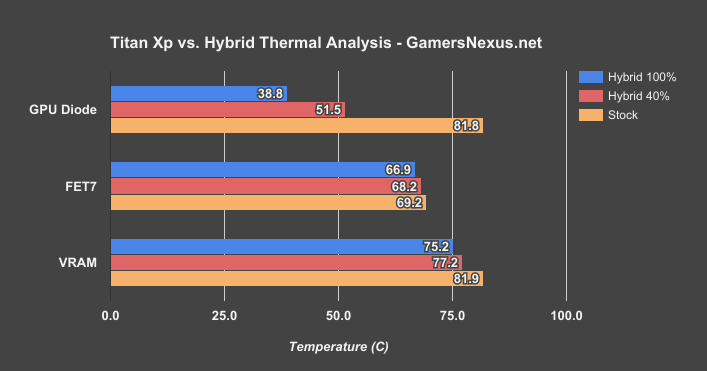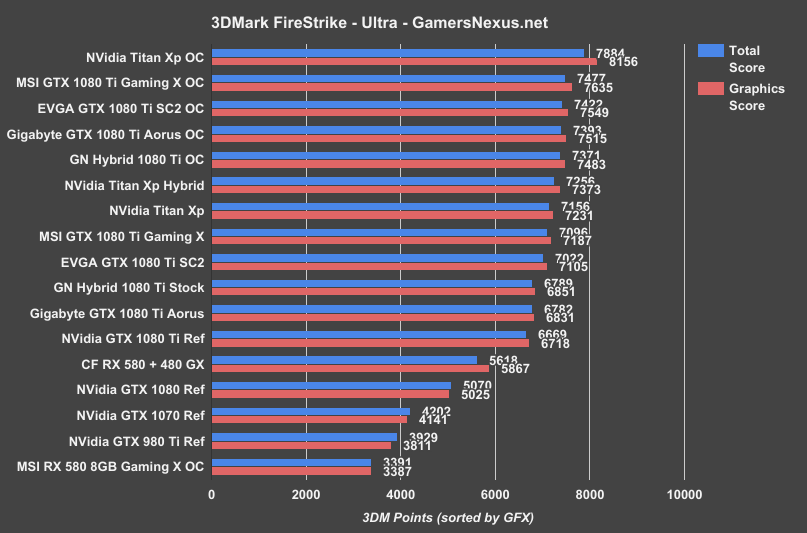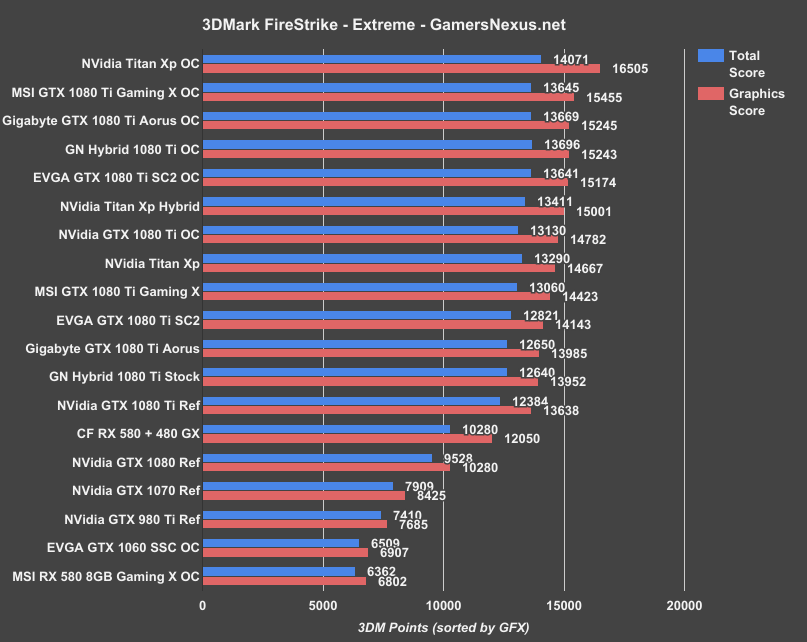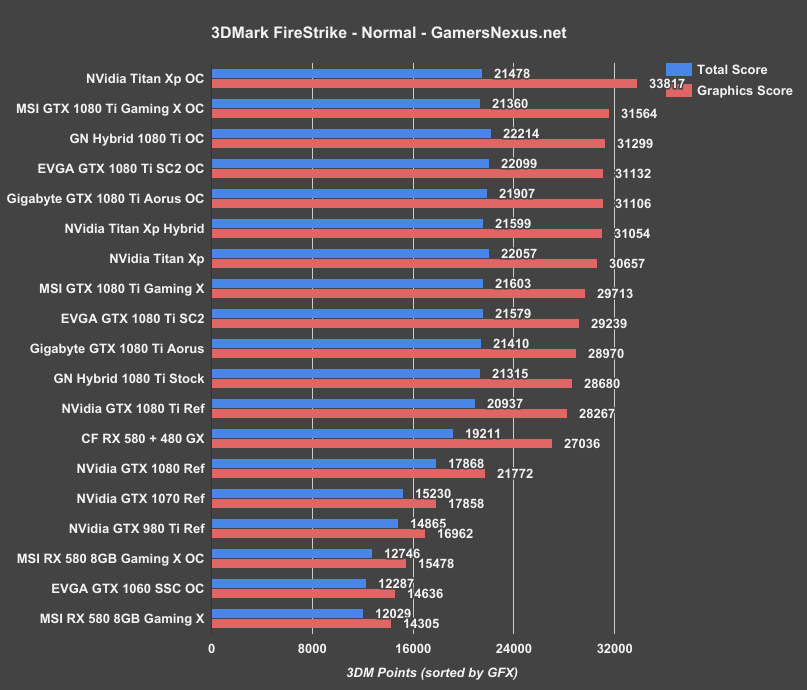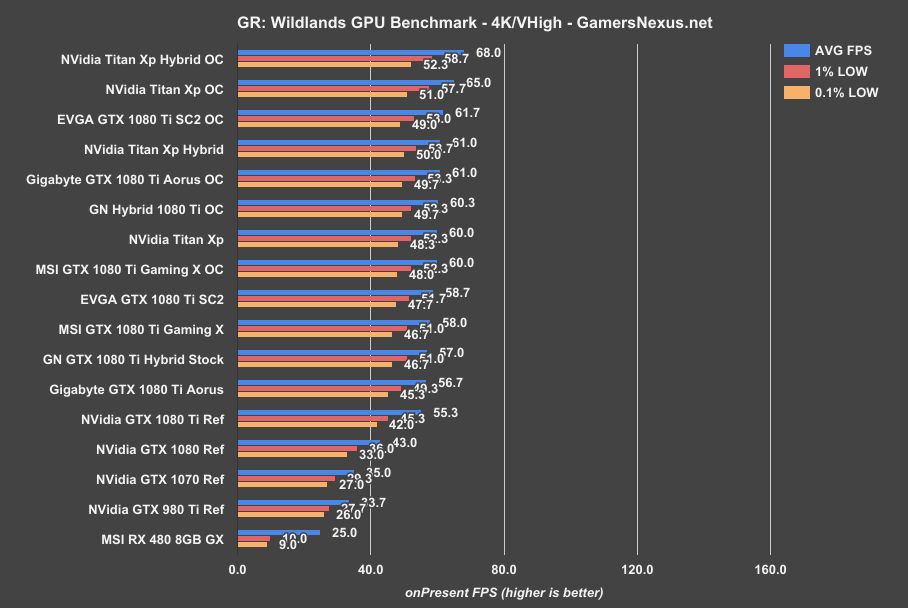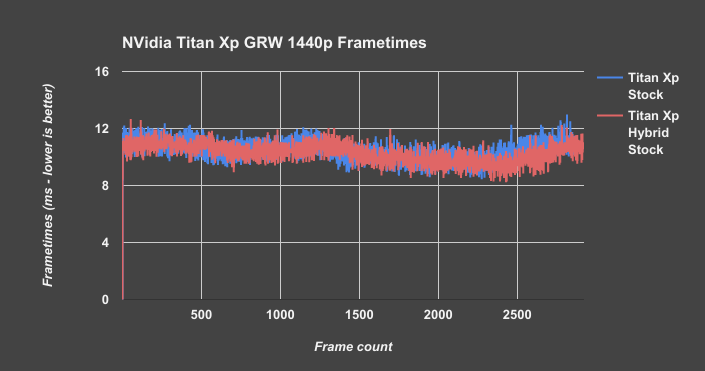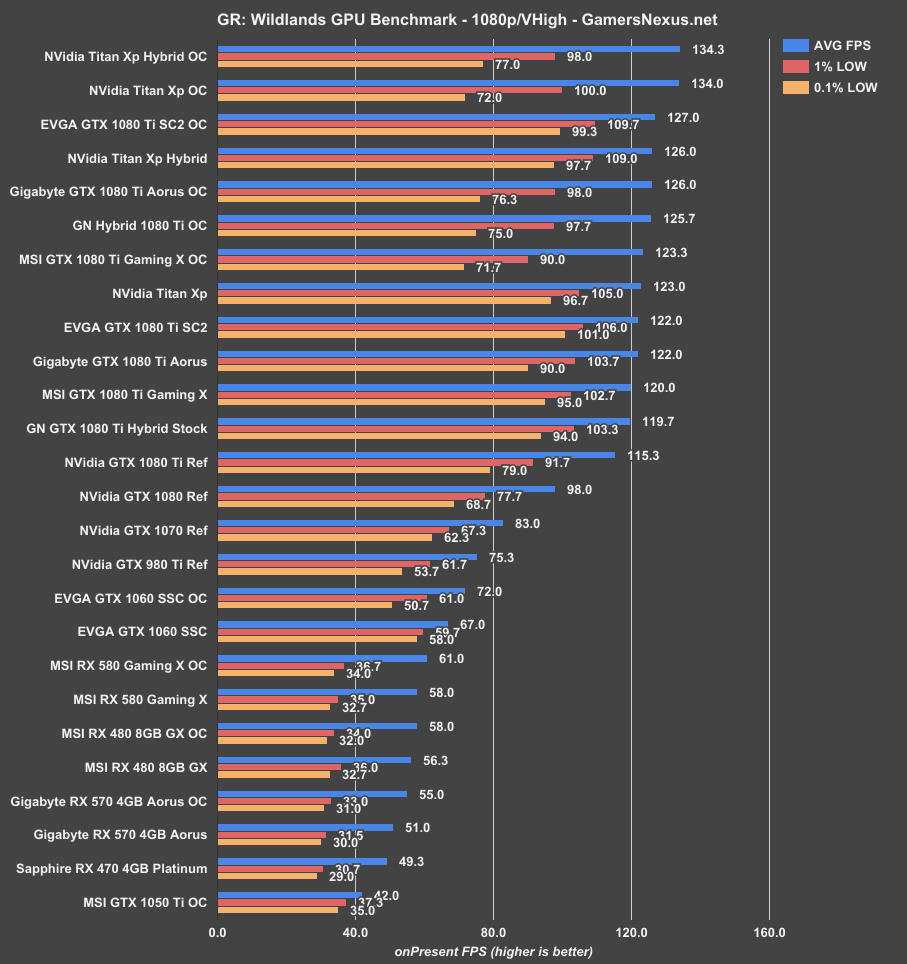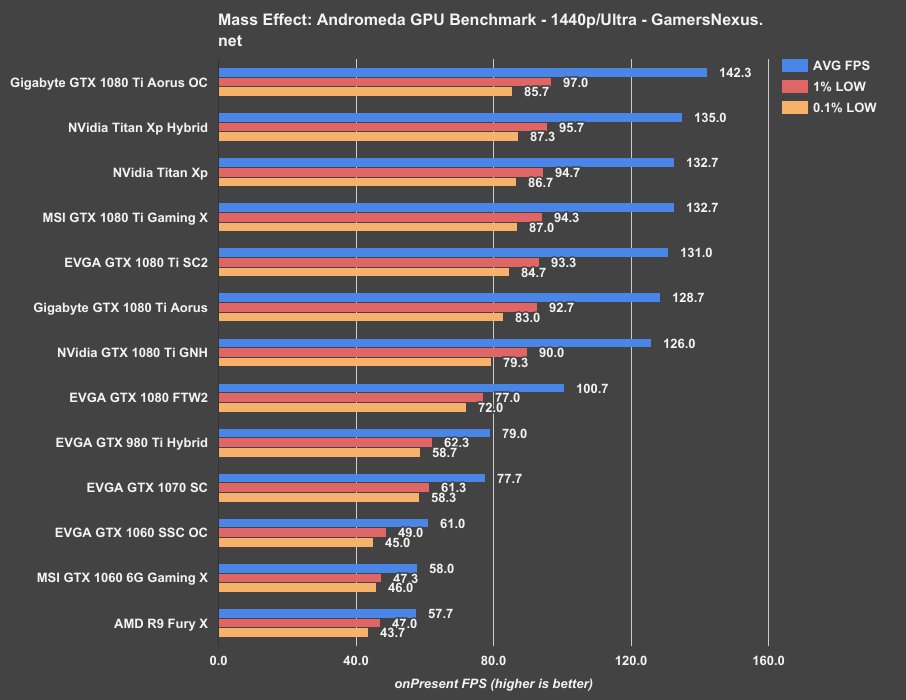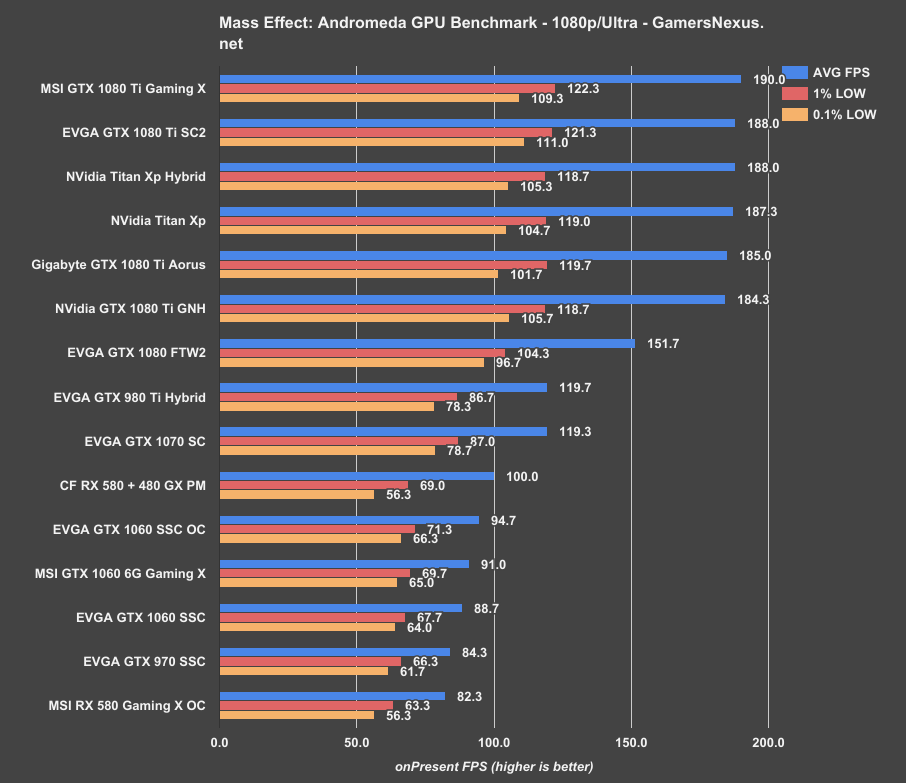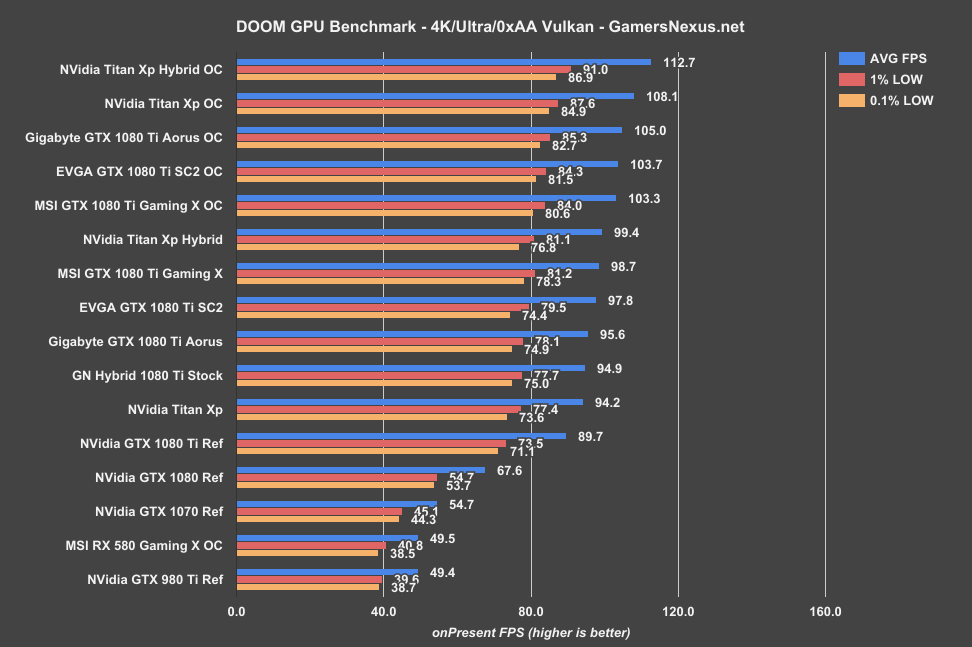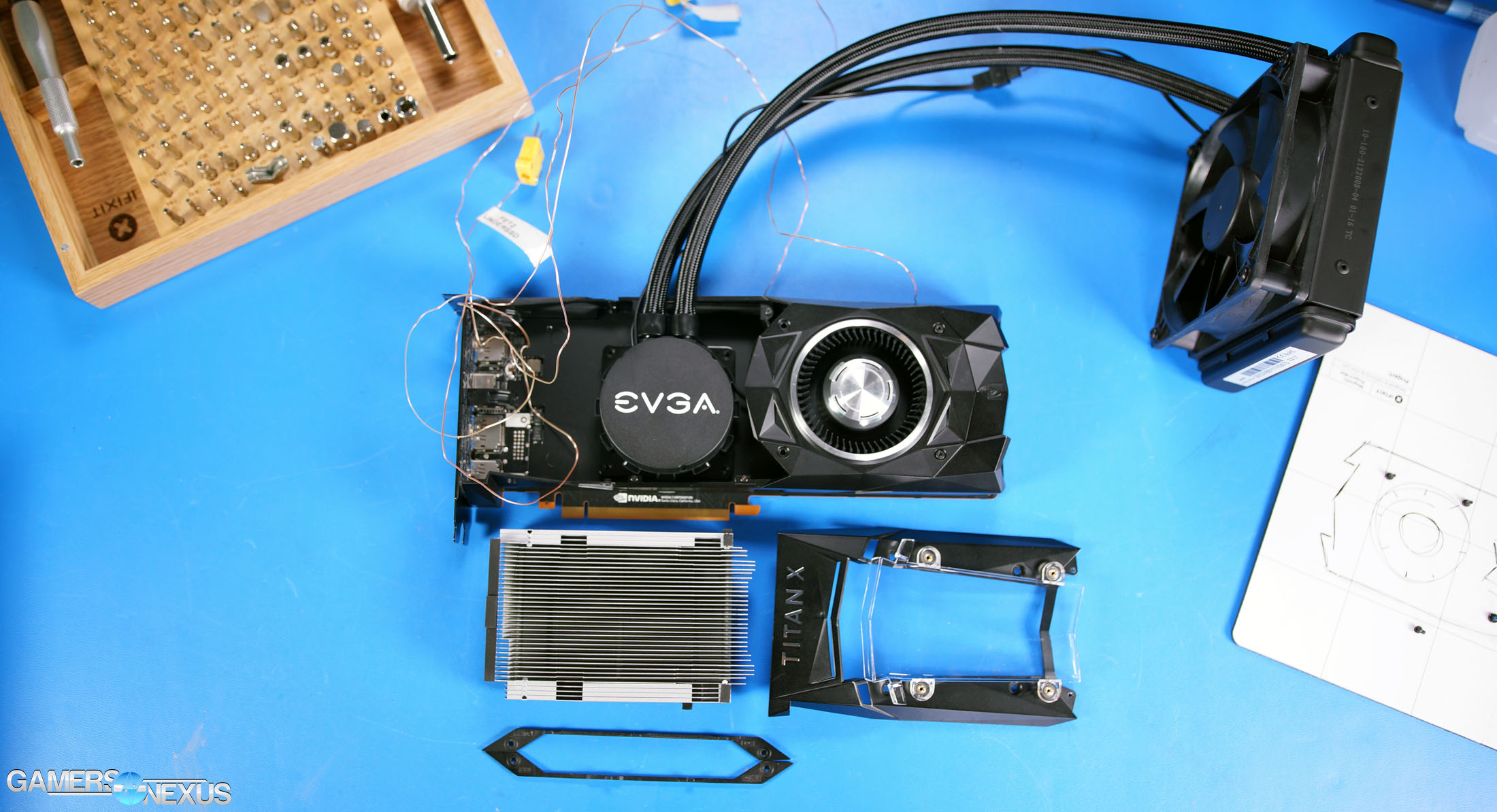NVidia Titan Xp (2017) Hybrid Mod Results: Reduced Noise v. Temperature
Posted on
Our Titan Xp Hybrid mod is done, soon to be shipped back to its owner in its new condition. Liquid cooling mods in the past have served as a means to better understand where a GPU could perform given a good cooler, and are often conducted on cards with reference coolers. The Titan Xp won’t have AIB partner cooler models, and so building a Hybrid card gives us a glimpse into what could have been.
It’s also not a hard mod to do – an hour tops, maybe a bit more for those who are more hesitant – and costs $100 for the Hybrid kit. Against the $1200 purchase for the card, that’s not a tall order.
In today’s benchmarks and conclusion of the Titan Xp Hybrid mod, we’ll cover thermals and noise levels extensively, overclocking, and throw in some gaming benchmarks.
Getting started with methodology:
GPU Testing Methodology
For our benchmarks today, we’re using a fully rebuilt GPU test bench for 2017. This is our first full set of GPUs for the year, giving us an opportunity to move to an i7-7700K platform that’s clocked higher than our old GPU test bed. For all the excitement that comes with a new GPU test bench and a clean slate to work with, we also lose some information: Our old GPU tests are completely incomparable to these results due to a new set of numbers, completely new testing , new game settings, and new games being tested with. DOOM, for instance, now has a new test behind it. We’ve moved to Ultra graphics settings with 0xAA and async enabled, also dropping OpenGL entirely in favor of Vulkan + more Dx12 tests.
We’ve also automated a significant portion of our testing at this point, reducing manual workload in favor of greater focus on analytics.
Driver version 378.78 (press-ready drivers for 1080 Ti, provided by nVidia) was used for all nVidia devices. Version 17.10.1030-B8 was used for AMD (press drivers). The Titan Xp used version 381.
A separate bench is used for game performance and for thermal performance.
Thermal Test Bench
Our test for the is largely parallel to our EVGA VRM final torture test that we published late last year. We use logging software to monitor the NTCs on EVGA’s ICX card, with our own calibrated thermocouples mounted to power components for non-ICX monitoring. Our thermocouples use an adhesive pad that is 1/100th of an inch thick, and does not interfere in any meaningful way with thermal transfer. The pad is a combination of polyimide and polymethylphenylsiloxane, and the thermocouple is a K-type hooked up to a logging meter. Calibration offsets are applied as necessary, with the exact same thermocouples used in the same spots for each test.
Torture testing used Kombustor's 'Furry Donut' testing, 3DMark, and a few games (to determine auto fan speeds under 'real' usage conditions, used later for noise level testing).
Our tests apply self-adhesive, 1/100th-inch thick (read: laser thin, does not cause "air gaps") K-type thermocouples directly to the rear-side of the PCB and to hotspot MOSFETs numbers 2 and 7 when counting from the bottom of the PCB. The thermocouples used are flat and are self-adhesive (from Omega), as recommended by thermal engineers in the industry -- including Bobby Kinstle of Corsair, whom we previously interviewed.
K-type thermocouples have a known range of approximately 2.2C. We calibrated our thermocouples by providing them an "ice bath," then providing them a boiling water bath. This provided us the information required to understand and adjust results appropriately.
Because we have concerns pertaining to thermal conductivity and impact of the thermocouple pad in its placement area, we selected the pads discussed above for uninterrupted performance of the cooler by the test equipment. Electrical conductivity is also a concern, as you don't want bare wire to cause an electrical short on the PCB. Fortunately, these thermocouples are not electrically conductive along the wire or placement pad, with the wire using a PTFE coating with a 30 AWG (~0.0100"⌀). The thermocouples are 914mm long and connect into our dual logging thermocouple readers, which then take second by second measurements of temperature. We also log ambient, and apply an ambient modifier where necessary to adjust test passes so that they are fair.
The response time of our thermocouples is 0.15s, with an accompanying resolution of 0.1C. The laminates arae fiberglass-reinforced polymer layers, with junction insulation comprised of polyimide and fiberglass. The thermocouples are rated for just under 200C, which is enough for any VRM testing (and if we go over that, something will probably blow, anyway).
To avoid EMI, we mostly guess-and-check placement of the thermocouples. EMI is caused by power plane PCBs and inductors. We were able to avoid electromagnetic interference by routing the thermocouple wiring right, toward the less populated half of the board, and then down. The cables exit the board near the PCI-e slot and avoid crossing inductors. This resulted in no observable/measurable EMI with regard to temperature readings.
The primary test platform is detailed below:
| GN Test Bench 2015 | Name | Courtesy Of | Cost |
| Video Card | This is what we're testing | - | - |
| CPU | Intel i7-5930K CPU 3.8GHz | iBUYPOWER | $580 |
| Memory | Corsair Dominator 32GB 3200MHz | Corsair | $210 |
| Motherboard | EVGA X99 Classified | GamersNexus | $365 |
| Power Supply | NZXT 1200W HALE90 V2 | NZXT | $300 |
| SSD | OCZ ARC100 Crucial 1TB | Kingston Tech. | $130 |
| Case | Top Deck Tech Station | GamersNexus | $250 |
| CPU Cooler | Asetek 570LC | Asetek | - |
Note also that we swap test benches for the GPU thermal testing, using instead our "red" bench with three case fans -- only one is connected (directed at CPU area) -- and an elevated standoff for the 120mm fat radiator cooler from Asetek (for the CPU) with Gentle Typhoon fan at max RPM. This is elevated out of airflow pathways for the GPU, and is irrelevant to testing -- but we're detailing it for our own notes in the future.
Game Bench
| GN Test Bench 2017 | Name | Courtesy Of | Cost |
| Video Card | This is what we're testing | - | - |
| CPU | Intel i7-7700K 4.5GHz locked | GamersNexus | $330 |
| Memory | GSkill Trident Z 3200MHz C14 | Gskill | - |
| Motherboard | Gigabyte Aorus Gaming 7 Z270X | Gigabyte | $240 |
| Power Supply | NZXT 1200W HALE90 V2 | NZXT | $300 |
| SSD | Plextor M7V Crucial 1TB | GamersNexus | - |
| Case | Top Deck Tech Station | GamersNexus | $250 |
| CPU Cooler | Asetek 570LC | Asetek | - |
BIOS settings include C-states completely disabled with the CPU locked to 4.5GHz at 1.32 vCore. Memory is at XMP1.
We communicated with both AMD and nVidia about the new titles on the bench, and gave each company the opportunity to ‘vote’ for a title they’d like to see us add. We figure this will help even out some of the game biases that exist. AMD doesn’t make a big showing today, but will soon. We are testing:
- Ghost Recon: Wildlands (built-in bench, Very High; recommended by nVidia)
- Sniper Elite 4 (High, Async, Dx12; recommended by AMD)
- For Honor (Extreme, manual bench as built-in is unrealistically abusive)
- Ashes of the Singularity (GPU-focused, High, Dx12)
- DOOM (Vulkan, Ultra, 0xAA, Async)
Synthetics:
- 3DMark FireStrike
- 3DMark FireStrike Extreme
- 3DMark FireStrike Ultra
- 3DMark TimeSpy
For measurement tools, we’re using PresentMon for Dx12/Vulkan titles and FRAPS for Dx11 titles. OnPresent is the preferred output for us, which is then fed through our own script to calculate 1% low and 0.1% low metrics (defined here).
Power testing is taken at the wall. One case fan is connected, both SSDs, and the system is otherwise left in the "Game Bench" configuration.
Continue to Page 2 for thermals & noise.
Titan Xp Hybrid – Frequency vs. Temperature
The first charts shows performance of the Titan Xp stock card against our Hybrid mod. Typically, we’ve seen improvement to the frequency stability (flattening of the line) by cooling the GPU with liquid, which helps with framerate consistency. In the case of this mod, there isn’t a tremendous frequency difference like we’ve seen in past mods – but there’s a big swing in thermals. We’ll talk more about that aspect in a moment.
With regard to clocks, the Hybrid mod is able to boost slightly higher in this power virus scenario, averaging about 1443MHz core, whereas the stock card ran 1392MHz. That’s an extra 50MHz without any overclocking effort, so not bad, but the Titan Xp is up against its clock limit already, so gains are minimal.
Note also that these tests are conducted with a power virus scenario, which means that the clock is enumerated differently from a gaming workload. That’s OK, because we’re just trying to stress the card thermally.
Titan Xp Stock vs. Hybrid Thermals
Getting into tests that involve thermocouple measurements on the VRAM and MOSFETs, we can compare the stock vs. Hybrid performance for various components. GPU diode temperatures were locked at around 84C with the stock cooler, which is the card’s thermal threshold for clock limiting. The MOSFETs were operating at around 68-70C in this scenario, well within reasonable operating range, and the VRAM was running parallel to GPU temperature at about 80-83C. This is important. By looking at how VRAM tends to follow GPU temperature, though at a slight delay (indicated at the 200-350 second mark), we learn that we need to pay attention to “thermal density” of the region around the GPU in addition to the GPU proper.
With our Hybrid mod using a 23% VRM fan and 100% radiator fan, we now see GPU diode temperatures around 40C, reducing the GPU diode reading. MOSFET and power component temperatures are almost identical, though note that the Hybrid does take longer to ramp its FET temperatures than the stock card. Ultimately, we’re not worse off for the FETs, but we can maintain equal temperatures with just 23% on the VRM fan, rather than north of 50%.
VRAM is interesting, and is the newest item we’ve added to our measurements. VRAM temperature with the Hybrid has dropped down to about 75C, whereas it was previously around 82C. Our current hypothesis is that this reduction is primarily because of the increased efficiency with which heat is removed from the GPU, reducing heat between all the VRAM modules. The VRAM is primarily cooled by the baseplate, so removing that vapor chamber didn’t hurt VRAM temperatures at all; in fact, it helped, since we can now focus all our air cooling efforts strictly on the power and VRAM components. The GPU is taken care of within a closed loop.
We also tested at 40% speed by plugging into the motherboard. This is where we can see that the 100% radiator fan speed exhibits diminishing returns, considering our 40% GPU diode temperature is only 12-13C higher and still around 50C max. Noise is measurably lower at this speed, as we’ll show in a bit, with temperatures still under control.
VRAM temperature is still improved with this fan speed, with FET temperatures still tied with the stock configuration.
Here’s a GN EQ chart to make things easier to read. Over the same test period and averaging a few hundred cells of data, after accounting for ambient, we see the Hybrid mod benefits performance of the measured power and VRAM components alongside the expected GPU diode improvement. It almost makes more sense to run a radiator fan to the motherboard at ~40%. We’re cooling everything adequately and operating at a lower noise level than stock, with 100% speeds on the EVGA fan not really posting significant benefits over 40%.
These components are exciting to start measuring, seeing as we’ve always known that Hybrid mods benefit GPU diode temperatures, but we weren’t sure how they affected componentry. Now we know.
All this talk about noise, let’s take a look.
First of all, that idle temperature we’ve listed for the Hybrid mod is when running our 40% noise profile from the previous charts – this means plugging the card into the motherboard and manually tuning it. At 40% on the radiator fan and 23% on the VRM fan, our idle noise output is about 32.5dBA – higher than idle for the other devices, including the original Titan Xp, but that’s because we’ve added another case fan to the mix.
Auto, where the radiator fan is running at 100%, our output is 39.1dBA. The stock cooler operated at around 48dBA here, which is nearly two times louder by human perception, given the logarithmic scale. Here’s the thing: If you wanted to keep that 40% radiator fan speed, since we’ve shown it worked just fine in our test configuration, the difference would be even bigger. We’d be looking at 47.9dBA for auto on the stock cooler, as opposed to 32.5dBA for the 40% radiator fan – and that’s while retaining a 23% VRM fan. 33dBA to 48dBA is a huge jump in perceived noise.
Continue to Page 3 for 3DMark tests.
3DMark & Synthetic Benchmarking
We're using 3DMark for synthetic benchmarking here, though won't begin data analysis until the next page. These charts are just for fans of 3DMark (like benchmarkers and overclockers) who like having the synthetic metrics on hand.
We're using 3DMark Firestrike - Normal, 3DMark Firestrike - Extreme, and 3DMark Firestrike - Ultra for testing, alongside TimeSpy. Continue to the next page for data analysis of games.
Continue to Page 4 for gaming benchmarks.
Gaming benchmarks aren’t quite as interesting as the thermal and noise results, but tell a story nonetheless. Our gaming tests largely consist of 4K for the Titan Xp, given its price, though we’ve got a couple 1440p results in the mix. As we descend from 4K toward 1080p, we start encountering CPU limitations that cause the GPUs to land tighter together, hence the focus on 4K.
Our overclocking endeavors weren’t much improved over the previous Titan Xp overclocking, with most improvements landing on increased peak clock per configuration. We ended up at roughly +25MHz higher on the offset, but encountered diminishing returns with VRAM overclocking. Despite stability nearing +600MHz on VRAM, we dropped down to 500MHz as it permitted a higher core clock (which is generally better for gaming).
Titan Xp Stock Overclock Stepping
| Peak Clock (MHz) | AVG Clock (MHz) | Core Offset (MHz) | MEM CLK (MHz) | MEM Offset (MHz) | Power Target | Voltage | Fan | TMP | Pass/Fail |
| 1810 | 1759 | 0 | 1425.6 | 0 | 100 | 0.93 | 2950 | 74 | P |
| 1835 | 1785 | 0 | 1425.6 | 0 | 120 | 0.98 | 2950 | 80 | P |
| 1873 | 1840 | 100 | 1425.6 | 0 | 120 | 0.98 | 2950 | 85 | P |
| 1924 | 1898 | 150 | 1425.6 | 0 | 120 | 0.98 | 3400 | 81 | P |
| 1962 | 1940 | 200 | 1425.6 | 0 | 120 | 0.98 | 3400 | 80 | P |
| - | - | 250 | 1425.6 | 0 | 120 | 0.98 | 3400 | 80 | F |
| 2076 | 1974 | 225 | 1425.6 | 0 | 120 | 0.98 | 3400 | 70 | F |
| 2114 | 1974 | 225 | 1425.6 | 0 | 120 | 1.08 | 3400 | 80 | F |
| 1974 | 1949 | 200 | 1475 | 200 | 120 | 0.98 | 3400 | 80 | P |
| 1974 | 1949 | 200 | 1539 | 450 | 120 | 0.98 | 3400 | 80 | P |
| 1974 | 1949 | 200 | 1553 | 500 | 120 | 0.98 | 3400 | 80 | P |
| 1974 | 1936 | 200 | 1575 | 600 | 120 | 0.98 | 3400 | 80 | F |
Titan Xp Hybrid Overclock Stepping
| Peak Clock (MHz) | AVG Clock (MHz) | Core Offset (MHz) | MEM CLK (MHz) | MEM Offset (MHz) | Power Target | Voltage | Fan | TMP | Pass/Fail |
| 1823 | 1785 | 0 | 1425.6 | 0 | 100 | 0.95 | 1000 | 36 | P |
| 1898 | 1860 | 0 | 1425.6 | 0 | 120 | 1.03 | 1000 | 41 | P |
| 1962 | 1936 | 100 | 1425.6 | 0 | 120 | 1.03 | 1000 | 43 | P |
| 2000 | 1974 | 150 | 1425.6 | 0 | 120 | 1.03 | 1000 | 43 | P |
| 2063 | 2025 | 200 | 1425.6 | 0 | 120 | 1.03 | 1000 | 43 | P |
| 2152 | - | 250 | 1425.6 | 0 | 120 | 1.03 | 1000 | 43 | F - Driver Crash |
| 2088 | 2050 | 225 | 1425.6 | 0 | 120 | 1.03 | 1000 | 43 | P |
| 2126 | - | 225 | 1425.6 | 0 | 120 | 1.06 | 1000 | 43 | F - Driver Crash |
| 2063 | 2050 | 225 | 1553 | 500 | 120 | 1.03 | 1000 | 43 | P |
| 2063 | 2025 | 225 | 1575 | 600 | 120 | 1.03 | 1000 | 43 | P |
| 2063 | 2050 | 225 | 1553 | 500 | 120 | 1.03 | 1000 | 43 | P |
Ghost Recon: Wildlands GPU Benchmark – Titan Xp Hybrid
Starting off with Ghost Recon: Wildlands at 4K, the Titan Xp stock card operated an average framerate of 60FPS, with lows at 52 and 48FPS. Without any overclock, our Titan Xp Hybrid improves to 61FPS, 54FPS 1% low, and 50FPS 0.1% lows. That’s not a huge jump at about 1.7% improvement, but it’s an improvement nonetheless. Overclocking the stock card landed us at 65FPS AVG, and overclocking the Hybrid bumped that to 68FPS. The result is a 4.6% improvement in performance when comparing OC to OC.
At 1440p, it’s a similar story: The stock Titan Xp runs a 95FPS AVG, 75FPS 1% low, and 72FPS 0.1% low. The Hybrid mod helps pull low performance up to 85 and 82, notably, with averages at 97FPS AVG. Overclocking performance shows the same limited gains: We experience a bump in AVG, with a bigger jump upward in frametime consistency.
Here’s a frametime chart showing the non-overclocked frametimes of the stock Titan Xp and the Hybrid Titan Xp, just to illustrate the difference.
And 1080p, if you care:
Mass Effect: Andromeda GPU Benchmark – Titan Xp Hybrid
Running Mass Effect: Andromeda at 4K, the Titan Xp stock card performed with an average of 68FPS, lows at 56 and 53, while the Hybrid version runs a 71FPS AVG and lows at 57 and 53. The stock-to-stock improvement is about 4.4% for this one.
Here are the 1440p and 1080p results:
More of the same, really. Gains are limited, with the liquid-cooled variant only posting few-FPS gains over the stock card.
DOOM (Vulkan) Benchmark – Titan Xp Hybrid
Let’s look at DOOM with Vulkan and Async enabled.
The Titan Xp stock card operated a framerate of 94FPS AVG, which improved to 108FPS AVG when overclocked. The Hybrid mod, meanwhile, lands at 99FPS AVG, so it’s 5.5% ahead of the stock Titan Xp cooler. Overclocking gets us to 113FPS AVG, for an increase of 4.3% over the Titan Xp air-cooled card when overclocked, or an improvement of 13% over the Hybrid mod with no OC.
Sniper Elite 4 (Dx12) - Titan Xp Hybrid
Sniper Elite 4 with Dx12 and Async places the Titan Xp stock at 87FPS AVG, with the Hybrid card bumping up to 94FPS without any overclocks applied – that’s just from the thermal headroom. This improves out performance by about 7.8% over the stock cooler. Overclocking the Titan Xp with its stock cooler gets the card to 98FPS AVG, for a gain of 12.2% over baseline. The Titan Xp Hybrid overclocked a bit higher and held on to the frametimes better, netting 101FPS AVG on the OC.
Conclusion: At $1200, an extra $100 doesn’t feel like a lot for cooling
This mod is more about thermal and noise improvements than raw throughput, evidently, as the gaming benchmarks posted minimal value for the Titan Xp. That said, “value” becomes a bit nebulous when spending $1200 on a GPU. Although we advise against the Titan Xp for gaming, anyone purchasing the card for gaming probably wants “the best” (despite a 1080 Ti competing directly with that), so might as well spend another $100 on a Hybrid mod.
What does matter, though, is the noise reduction. We’re nearly 2x quieter in perceived noise between the stock card and Hybrid card when operating the radiator fan at 40%. This still permits far and away superior thermals (even on VRAM), but reduces noise significantly. Check back on Page 2 for those details.
It’s an easy mod overall. Not that exciting for gaming and overclocking, but great for noise.
Editor-in-Chief: Steve Burke
Video Producer: Andrew Coleman



